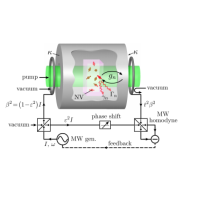News
A Polariton-Stabilized Spin Clock

Figure: A polaritonic-stabilized spin clock. The reference probe field at frequency ω with intensity I is is split into a local oscillator and probe. The latter is sent to the resonant system, which consists of NV centers in diamond with population relaxation rate γ coupled to a microwave cavity at rate g.
Atomic clocks are among the most precise instruments in the world today, providing the foundation for critical global infrastructure among their many applications from telecommunications to fundamental science. In recent years, “artificial atoms” in the solid-state (e.g. the nitrogen-vacancy center in diamond) have gained prominence in quantum technology as alternatives to traditional atomic or ionic systems as they provide long quantum coherence and ambient operation. However, the inherent thermal dependence of these solid-state systems, due to interactions with the surrounding crystal lattice, has severely restricted their frequency stability. In this CUA-supported work, a collaboration of researchers from MIT, MIT-LL, and Army Research Laboratory offer a solution to this problem: they show that the thermal dependence can be eliminated to first order by using spin-photon coupling in the microwave domain, resulting in a stability improvement of over five orders of magnitude. They evaluated the “polariton-stabilized spin clock” using a rigorous quantum-mechanical open-systems formalism to predict the achievable fractional frequency deviation in the presence of realistic thermal and magnetic fluctuations alongside quantum shot noise. This analysis shows that the PSSC can reach an instability level of 10^-13 after one second of averaging.
These results open the path to a new generation of solid-state quantum clocks and precision oscillators with performance that is competitive or exceeds that of modern miniaturized clocks based on atomic vapors.
